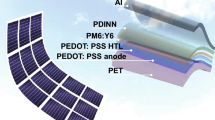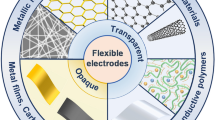Abstract
The flexibility and translucency aspects are unparalleled advantages of organic solar cells (OSCs), which have attracted great attention from the scientific and industrial communities. Currently, the key to improve the performance of flexible semi-transparent OSCs (ST-OSCs) lies in flexible transparent electrodes (FTEs) and the light-absorbing active layer. Herein, high-quality multi-layer FTEs with solar-weighted transmittance of 84.8% are employed, which allows the photo-active layer to effectively capture light and improve the light management in devices. In addition, multiple well-developed strategies, including alloy-like near-infrared acceptors (Y6:m-BTP-PhC6) and dilution of the donor with visible-range absorption (PM6), precisely utilize each band of photons, significantly balancing the conflict between photovoltaic and optical properties in ST-OSCs. The dilution of PM6 leads to highly transparent active layers with average visible transmittance of 39.3%, which is due to a decrease in donor absorption in the visible range and an increase in near-infrared absorption of the acceptor. As a result, high efficiencies of 16.44% and 11.48% are obtained for flexible opaque and semi-transparent cells. To the best of our knowledge, these results represent one of the best values for ST-OSCs based on flexible substrates. This work paves the path for realizing high-performance flexible ST-OSCs with excellent mechanical robustness, and contributes a major step toward practical applications.

摘要
柔性和半透明是有机太阳能电池(OSCs)的重要优势, 受到科学界和工业界的广泛关注. 目前, 提高柔性半透明OSCs(ST-OSCs)性能的关键是柔性透明电极(FTEs)和吸光活性层. 本文制备了透过率为84.8%的复合FTEs, 这使得活性层可以高效捕获太阳光, 优化了器件中的光管理. 此外, 在活性层中采用了多种成熟的策略, 包括构筑类合金近红外受体(Y6:m-BTP-PhC6)和稀释可见光范围强吸收的给体(PM6), 使得每个光子被精确利用, 有效平衡了ST-OSCs效率和透过率之间的冲突. 利用以上策略, 提高了活性层中可见光的透过和近红外光的吸收, 最终获得了高透明度的活性层, 其平均可见光透过率(AVT)值为39.3%. 基于此, 柔性不透明和半透明OSCs分别获得了16.44%和11.48%的能量转换效率, 这是目前柔性ST-OSCs的最高效率之一. 本工作对实现具有优异鲁棒性和高性能的ST-OSCs具有重要的指导意义, 也为其实际应用迈出了重要一步.
Similar content being viewed by others
References
Ravishankar E, Booth RE, Saravitz C, et al. Achieving net zero energy greenhouses by integrating semitransparent organic solar cells. Joule, 2020, 4: 490–506
Meitzner R, Schubert US, Hoppe H. Agrivoltaics—The perfect fit for the future of organic photovoltaics. Adv Energy Mater, 2020, 11: 2002551
Clark MA, Domingo NGG, Colgan K, et al. Global food system emissions could preclude achieving the 1.5° and 2°C climate change targets. Science, 2020, 370: 705–708
Wang D, Li Y, Zhou G, et al. High-performance see-through power windows. Energy Environ Sci, 2022, 15: 2629–2637
Jiang Y, Dong X, Sun L, et al. An alcohol-dispersed conducting polymer complex for fully printable organic solar cells with improved stability. Nat Energy, 2022, 7: 352–359
Zhang M, Zhu L, Hao T, et al. High-efficiency organic photovoltaics using eutectic acceptor fibrils to achieve current amplification. Adv Mater, 2021, 33: 2007177
Ravishankar E, Charles M, Xiong Y, et al. Balancing crop production and energy harvesting in organic solar-powered greenhouses. Cell Rep Phys Sci, 2021, 2: 100381
Ge J, Xie L, Peng R, et al. 13.34 % efficiency non-fullerene all-small-molecule organic solar cells enabled by modulating the crystallinity of donors via a fluorination strategy. Angew Chem Int Ed, 2020, 59: 2808–2815
Xie L, Song W, Ge J, et al. Recent progress of organic photovoltaics for indoor energy harvesting. Nano Energy, 2021, 82: 105770
Sun R, Wu Y, Yang X, et al. Single-junction organic solar cells with 19.17% efficiency enabled by introducing one asymmetric guest acceptor. Adv Mater, 2022, 34: 2110147
Wei Y, Chen Z, Lu G, et al. Binary organic solar cells breaking 19% via manipulating the vertical component distribution. Adv Mater, 2022, 34: 2204718
Chong K, Xu X, Meng H, et al. Realizing 19.05% efficiency polymer solar cells by progressively improving charge extraction and suppressing charge recombination. Adv Mater, 2022, 34: 2109516
Xu T, Lv J, Yang K, et al. 15.8% Efficiency binary all-small-molecule organic solar cells enabled by a selenophene substituted sematic liquid crystalline donor. Energy Environ Sci, 2021, 14: 5366–5376
Peng W, Lin Y, Jeong SY, et al. Over 18% ternary polymer solar cells enabled by a terpolymer as the third component. Nano Energy, 2022, 92: 106681
Lin Y, Adilbekova B, Firdaus Y, et al. 17% efficient organic solar cells based on liquid exfoliated WS2 as a replacement for PEDOT:PSS. Adv Mater, 2019, 31: 1902965
Yao J, Qiu B, Zhang ZG, et al. Cathode engineering with perylenediimide interlayer enabling over 17% efficiency single-junction organic solar cells. Nat Commun, 2020, 11: 2726
Wijeyasinghe N, Regoutz A, Eisner F, et al. Copper(I) thiocyanate (CuSCN) hole-transport layers processed from aqueous precursor solutions and their application in thin-film transistors and highly efficient organic and organometal halide perovskite solar cells. Adv Funct Mater, 2017, 27: 1701818
Zheng Z, Wang J, Bi P, et al. Tandem organic solar cell with 20.2% efficiency. Joule, 2022, 6: 171–184
Huang Y, Meng L, Liang H, et al. Tandem organic solar cells with 18.67% efficiency via careful subcell design and selection. J Mater Chem A, 2022, 10: 11238–11245
Huang J, Ren Z, Zhang Y, et al. Tandem self-powered flexible electrochromic energy supplier for sustainable all-day operations. Adv Energy Mater, 2022, 12: 2201042
Song W, Fan X, Xu B, et al. All-solution-processed metal-oxide-free flexible organic solar cells with over 10% efficiency. Adv Mater, 2018, 30: 1800075
Song W, Peng R, Huang L, et al. Over 14% efficiency folding-flexible ITO-free organic solar cells enabled by eco-friendly acid-processed electrodes. iScience, 2020, 23: 100981
Hu Z, Wang J, Ma X, et al. Semitransparent organic solar cells exhibiting 13.02% efficiency and 20.2% average visible transmittance. J Mater Chem A, 2021, 9: 6797–6804
Song Y, Zhang K, Dong S, et al. Semitransparent organic solar cells enabled by a sequentially deposited bilayer structure. ACS Appl Mater Interfaces, 2020, 12: 18473–18481
Emmott CJM, Röhr JA, Campoy-Quiles M, et al. Organic photovoltaic greenhouses: A unique application for semi-transparent PV? Energy Environ Sci, 2015, 8: 1317–1328
Loik ME, Carter SA, Alers G, et al. Wavelength-selective solar photovoltaic systems: Powering greenhouses for plant growth at the food-energy-water nexus. Earths Future, 2017, 5: 1044–1053
Burgués-Ceballos I, Lucera L, Tiwana P, et al. Transparent organic photovoltaics: A strategic niche to advance commercialization. Joule, 2021, 5: 2261–2272
Song W, Liu Y, Fanady B, et al. Ultra-flexible light-permeable organic solar cells for the herbal photosynthetic growth. Nano Energy, 2021, 86: 106044
Xia Y, Liang X, Jiang Y, et al. High-efficiency and reliable smart photovoltaic windows enabled by multiresponsive liquid crystal composite films and semi-transparent perovskite solar cells. Adv Energy Mater, 2019, 9: 1900720
Xue Q, Xia R, Brabec CJ, et al. Recent advances in semi-transparent polymer and perovskite solar cells for power generating window applications. Energy Environ Sci, 2018, 11: 1688–1709
Shi H, Xia R, Zhang G, et al. Spectral engineering of semitransparent polymer solar cells for greenhouse applications. Adv Energy Mater, 2019, 9: 1803438
Mescher J, Kettlitz SW, Christ N, et al. Design rules for semi-transparent organic tandem solar cells for window integration. Org Electron, 2014, 15: 1476–1480
Yu Z, Li L, Zhang Q, et al. Silver nanowire-polymer composite electrodes for efficient polymer solar cells. Adv Mater, 2011, 23: 4453–4457
Liu Y, Cheng P, Li T, et al. Unraveling sunlight by transparent organic semiconductors toward photovoltaic and photosynthesis. ACS Nano, 2019, 13: 1071–1077
Song W, Yu K, Ge J, et al. Entangled structure morphology by polymer guest enabling mechanically robust organic solar cells with efficiencies of over 16.5%. Matter, 2022, 5: 1877–1889
Song W, Fanady B, Peng R, et al. Foldable semitransparent organic solar cells for photovoltaic and photosynthesis. Adv Energy Mater, 2020, 10: 2000136
Chen X, Xu G, Zeng G, et al. Realizing ultrahigh mechanical flexibility and >15% efficiency of flexible organic solar cells via a “welding” flexible transparent electrode. Adv Mater, 2020, 32: 1908478
Wang G, Zhang J, Yang C, et al. Synergistic optimization enables large-area flexible organic solar cells to maintain over 98% PCE of the small-area rigid devices. Adv Mater, 2020, 32: 2005153
Chen Z, Song W, Yu K, et al. Small-molecular donor guest achieves rigid 18.5% and flexible 15.9% efficiency organic photovoltaic via fine-tuning microstructure morphology. Joule, 2021, 5: 2395–2407
Li Y, Xu G, Cui C, et al. Flexible and semitransparent organic solar cells. Adv Energy Mater, 2018, 8: 1701791
Xie Y, Xia R, Li T, et al. Highly transparent organic solar cells with all-near-infrared photoactive materials. Small Methods, 2019, 3: 1900424
Xia R, Gu H, Liu S, et al. Optical analysis for semitransparent organic solar cells. Sol RRL, 2019, 3: 1800270
Huang X, Oh J, Cheng Y, et al. Narrow band-gap materials with overlapping absorption simultaneously increase the open circuit voltage and average visible transmittance of semitransparent organic solar cells. J Mater Chem A, 2021, 9: 5711–5719
Cheng P, Yang Y. Narrowing the band gap: The key to high-performance organic photovoltaics. Acc Chem Res, 2020, 53: 1218–1228
Schopp N, Akhtanova G, Panoy P, et al. Unraveling device physics of dilute-donor narrow-bandgap organic solar cells with highly transparent active layers. Adv Mater, 2022, 34: 2203796
Leem JW, Kim S, Lee SH, et al. Efficiency enhancement of organic solar cells using hydrophobic antireflective inverted moth-eye nanopatterned PDMS films. Adv Energy Mater, 2014, 4: 1301315
Sun R, Deng D, Guo J, et al. Spontaneous open-circuit voltage gain of fully fabricated organic solar cells caused by elimination of interfacial energy disorder. Energy Environ Sci, 2019, 12: 2518–2528
Xiao Y, Lu X. Morphology of organic photovoltaic non-fullerene acceptors investigated by grazing incidence X-ray scattering techniques. Mater Today Nano, 2019, 5: 100030
Song J, Zhang M, Yuan M, et al. Morphology characterization of bulk heterojunction solar cells. Small Methods, 2018, 2: 1700229
An Q, Ma X, Gao J, et al. Solvent additive-free ternary polymer solar cells with 16.27% efficiency. Sci Bull, 2019, 64: 504–506
Du B, Geng R, Li W, et al. 13.9% Efficiency ternary nonfullerene organic solar cells featuring low-structural order. ACS Energy Lett, 2019, 4: 2378–2385
Acknowledgements
This work was financially supported by the National Natural Science Fund for Distinguished Young Scholars (21925506), the National Natural Science Foundation of China (U21A20331 and 81903743), Ningbo S&T Innovation 2025 Major Special Programme (2018B10055), CAS Key Project of Frontier Science Research (QYZDBSSW-SYS030), Ningbo Natural Science Foundation (2021J192), Ningbo Key Scientific and Technological Project (2022Z117), Ningbo Public Welfare Science and Technology Planning Project (2021S149), and ZBTI Scientific Research Innovation Team (KYTD202105).
Author information
Authors and Affiliations
Contributions
Li Y performed the fabrication and characterization of devices. Song W conducted the data analysis. Zhang J performed the GIWAXS measurement and analyzed the results. Zhang X provided feedbacks regarding overall data analysis. The project was supervised and directed by Song W and Ge Z. Song W wrote the manuscript with contributions from Li Y, Zhang X and Ge Z. All authors commented on the manuscript for improvements.
Corresponding authors
Additional information
Conflict of interest
The authors declare that they have no conflict of interest.
Supplementary information
Experimental details and supporting data are available in the online version of the paper.
Yafeng Li received her PhD degree in information and communication systems from Ningbo University, China. She is currently an associate professor at Zhejiang Business Technology Institute. Her current research interests include information processing, circuit design and organic solar cells.
Wei Song received his PhD degree in 2022 under the supervision of Prof. Ziyi Ge from Ningbo Institute of Materials Technology and Engineering (NIMTE), Chinese Academy of Sciences. Currently, he works in collaboration with Prof. Ziyi Ge as a post-doctor at NIMTE, Chinese Academy of Sciences. His research focuses on the development of flexible photovoltaic devices via device engineering and their applications in wearable electronic systems.
Ziyi Ge received his PhD degree from the Institute of Chemistry, Chinese Academy of Sciences in 2004. He conducted his postdoctoral research on organic electronics at Tokyo Institute of Technology, Kanagawa University, Japan and the University of New South Wales, Australia during 2005–2009. Currently, he is the leader of the Group of Organic Electronic Material and Device at NIMTE, Chinese Academy of Sciences. His research interests focus on organic/perovskite solar cells and organic-light-emitting diodes.
Rights and permissions
About this article
Cite this article
Li, Y., Song, W., Zhang, J. et al. High-performance and mechanically durable semi-transparent organic solar cells with highly transparent active layers. Sci. China Mater. 66, 1719–1726 (2023). https://doi.org/10.1007/s40843-022-2332-9
Received:
Accepted:
Published:
Issue Date:
DOI: https://doi.org/10.1007/s40843-022-2332-9




